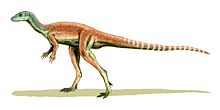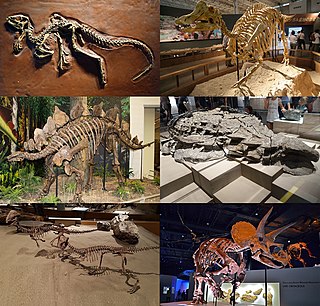
Ornithischia is an extinct order of mainly herbivorous dinosaurs characterized by a pelvic structure superficially similar to that of birds. The name Ornithischia, or "bird-hipped", reflects this similarity and is derived from the Greek stem ornith- (ὀρνιθ-), meaning "of a bird", and ischion (ἴσχιον), plural ischia, meaning "hip joint". However, birds are only distantly related to this group as birds are theropod dinosaurs. Ornithischians with well known anatomical adaptations include the ceratopsians or "horn-faced" dinosaurs, the pachycephalosaurs or "thick-headed" dinosaurs, the armored dinosaurs (Thyreophora) such as stegosaurs and ankylosaurs, and the ornithopods. There is strong evidence that certain groups of ornithischians lived in herds, often segregated by age group, with juveniles forming their own flocks separate from adults. Some were at least partially covered in filamentous pelts, and there is much debate over whether these filaments found in specimens of Tianyulong, Psittacosaurus, and Kulindadromeus may have been primitive feathers.
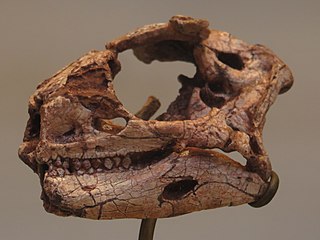
Lesothosaurus is a monospecific genus of ornithischian dinosaur that lived during the Early Jurassic in what is now South Africa and Lesotho. It was named by paleontologist Peter Galton in 1978, the name meaning "lizard from Lesotho". The genus has only one valid species, Lesothosaurus diagnosticus. Lesothosaurus is one of the most completely-known early ornithischians, based on numerous skull and postcranial fossils from the Upper Elliot Formation. It had a simpler tooth and jaw anatomy than later ornithischians, and may have been omnivorous in some parts of the year.
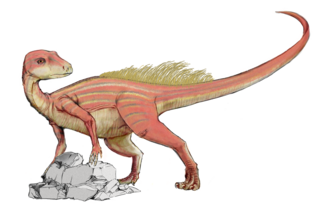
Abrictosaurus is a genus of heterodontosaurid dinosaur that lived during the Early Jurassic in what is now in parts of southern Africa such as Lesotho and South Africa. It was a bipedal herbivore or omnivore and was one of the most basal heterodontosaurids. It was approximately 1.2 metres (3.9 ft) long and weighed between 0.68 and 3 kilograms.

Scelidosaurus is a genus of herbivorous armoured ornithischian dinosaur from the Jurassic of the British Isles.
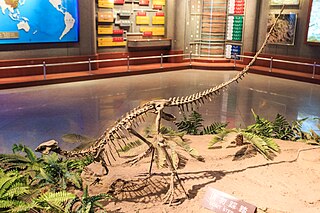
Agilisaurus is a genus of ornithischian dinosaur from the Middle Jurassic Period of what is now eastern Asia. It was about 3.5–4 ft long, 2 ft in height and 40 kg in weight.

Echinodon is a genus of heterodontosaurid dinosaur that lived during the earliest Cretaceous of southern England and possibly western France in the Berriasian epoch. The first specimens were jaw bones named Echinodon becklesii by Sir Richard Owen in 1861, and since their original description only additional teeth have been discovered. The specific name honours collector Samuel Beckles who discovered the material of Echinodon and many other taxa from across England, while the genus name translates as "prickly tooth" in reference to the dental anatomy of the taxon.
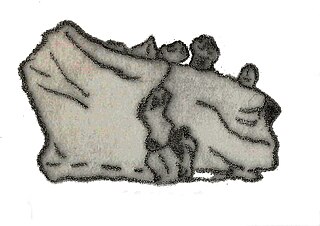
Fabrosaurus is an extinct genus of ornithischian dinosaur that lived during the Early Jurassic during the Hettangian to Sinemurian stages 199 - 189 mya. It was originally placed within the now obsolete family Fabrosauridae.

Heterodontosaurus is a genus of heterodontosaurid dinosaur that lived during the Early Jurassic, 200–190 million years ago. Its only known member species, Heterodontosaurus tucki, was named in 1962 based on a skull discovered in South Africa. The genus name means "different toothed lizard", in reference to its unusual, heterodont dentition; the specific name honours G. C. Tuck, who supported the discoverers. Further specimens have since been found, including an almost complete skeleton in 1966.

Neornithischia is a clade of the dinosaur order Ornithischia. It is the sister group of the Thyreophora within the clade Genasauria. Neornithischians are united by having a thicker layer of asymmetrical enamel on the inside of their lower teeth. The teeth wore unevenly with chewing and developed sharp ridges that allowed neornithischians to break down tougher plant food than other dinosaurs. Neornithischians include a variety of basal forms historically known as "hypsilophodonts", including the Parksosauridae; in addition, there are derived forms classified in the groups Marginocephalia and Ornithopoda. The former includes clades Pachycephalosauria and Ceratopsia, while the latter typically includes Hypsilophodon and the more derived Iguanodontia.
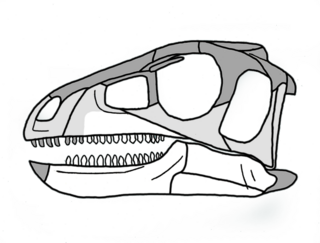
Pisanosaurus is an extinct genus of early dinosauriform, likely an ornithischian or silesaurid, from the Late Triassic of Argentina. It was a small, lightly built, ground-dwelling herbivore, that could grow up to an estimated 1 m (3.3 ft) long. Only one species, the type, Pisanosaurus mertii, is known, based on a single partial skeleton discovered in the Ischigualasto Formation of the Ischigualasto-Villa Unión Basin in northwestern Argentina. This part of the formation has been dated to the late Carnian, approximately 229 million years ago.
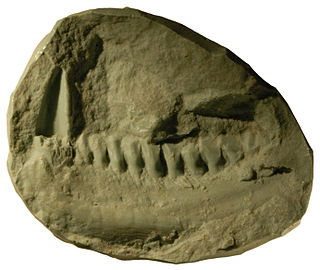
Lycorhinus is a genus of heterodontosaurid ornithischian dinosaur from the Early Jurassic strata of the Elliot Formation located in the Cape Province, South Africa.

Heterodontosauridae is a family of ornithischian dinosaurs that were likely among the most basal (primitive) members of the group. Their phylogenetic placement is uncertain but they are most commonly found to be primitive, outside of the group Genasauria. Although their fossils are relatively rare and their group small in numbers, they have been found on all continents except Australia and Antarctica, with a range spanning the Early Jurassic to the Early Cretaceous.

Genasauria is a clade of extinct beaked, primarily herbivorous dinosaurs. Paleontologist Paul Sereno first named Genasauria in 1986. The name Genasauria is derived from the Latin word gena meaning ‘cheek’ and the Greek word saúra (σαύρα) meaning ‘lizard.’ It is hypothesized that Genasauria had diverged from Lesothosaurus by the Early Jurassic. Cranial features that characterize Genasauria include a medial offset of the maxillary dentition, a sprout-shaped mandibular symphysis, moderately sized coronoid process, and an edentulous anterior portion of the premaxilla. A distinguishing postcranial feature of Genasauria is a pubic peduncle of the ilium that is less robust than the ischial peduncle. Genasauria is commonly divided into Neornithischia and Thyreophora. Neornithischia is characterized by asymmetrical distributions of enamel covering the crowns of the cheek teeth, an open acetabulum, and a laterally protruding ischial peduncle of the ilium. Neornithischia includes ornithopods, pachycephalosaurs, and ceratopsians. Thyreophora is characterized by body armor and includes stegosaurs, ankylosaurs, Scelidosaurus, and Scutellosaurus.

The Elliot Formation is a geological formation and forms part of the Stormberg Group, the uppermost geological group that comprises the greater Karoo Supergroup. Outcrops of the Elliot Formation have been found in the northern Eastern Cape, southern Free State, and in the eastern KwaZulu-Natal provinces of South Africa. Outcrops and exposures are also found in several localities in Lesotho such as Qacha's Neck, Hill Top, Quthing, and near the capital, Maseru. The Elliot Formation is further divided into the lower (LEF) and upper (UEF) Elliot formations to differentiate significant sedimentological differences between these layers. The LEF is dominantly Late Triassic (Norian-Hettangian) in age while the UEF is mainly Early Jurassic (Sinemurian-Pliensbachian) and is tentatively regarded to preserve a continental record of the Triassic-Jurassic boundary in southern Africa. This geological formation is named after the town of Elliot in the Eastern Cape, and its stratotype locality is located on the Barkly Pass, 9 km north of the town.
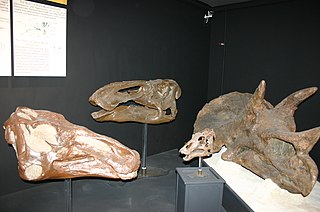
Cerapoda is a clade of the dinosaur order Ornithischia, that includes pachycephalosaurs, ceratopsians and ornithopods

Diodorus is a genus of silesaurid dinosauromorph that lived during the Late Triassic of what is now Morroco. Fossils were discovered in the Timezgadiouine Formation of the Argana Basin, and were used to name the new genus and species Diodorus scytobrachion. The genus name honours Diodorus, a legendary king of the Berber people, and Diodorus Siculus, a 1st-century historian, while the specific name is ancient Greek for "leathery arm". The holotype specimen is a partial dentary bone, and assigned specimens include isolated teeth, two humeri, a metatarsal, and femur.
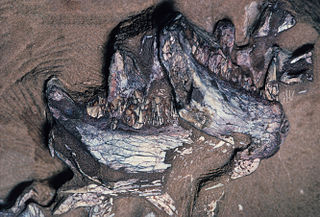
Pegomastax is a genus of heterodontosaurid dinosaur that lived during the Early Jurassic of South Africa. The only known specimen was discovered in a 1966-1967 expedition in Transkei District of Cape Province, but wasn't described until 2012 when Paul Sereno named it as the new taxon Pegomastax africana. The genus name is derived from the Greek for "strong jaw", and the species name describes the provenance of Africa; it was originally spelled africanus, was corrected to africana to align with the gender of the genus name.

Megapnosaurus is an extinct genus of coelophysid theropod dinosaur that lived approximately 188 million years ago during the early part of the Jurassic Period in what is now Africa. The species was a small to medium-sized, lightly built, ground-dwelling, bipedal carnivore, that could grow up to 2.2 m (7.2 ft) long and weigh up to 13 kg (29 lb). It was originally given the genus name Syntarsus, but that name was later determined to be preoccupied by a beetle. The species was subsequently given a new genus name, Megapnosaurus, by Ivie, Ślipiński & Węgrzynowicz in 2001. Some studies have classified it as a species within the genus Coelophysis, but this interpretation has been challenged by more subsequent studies and the genus is now considered valid.

Laquintasaura is a genus of Venezuelan ornithischian dinosaur containing only the type species Laquintasaura venezuelae. The species was the first dinosaur to have been identified from Venezuela. It is known from extensive remains, all from a singular bonebed locality which has been sampled for specimen blocks over the course of several expeditions, largely led by Marcelo R Sánchez-Villagra. A small, very primitive animal, it is known for its distinct dental anatomy and for being one of the earliest and most primitive ornithischians in the fossil record. Taxonomic uncertainty has led to conflicting theories that it is either as the base of Ornithischia or at the base of the subgroup Thyreophora. In either model, its dating to around 200 million years ago, at the start of the Jurassic, existence in equatorial latitudes, and primitive nature make it a key view into early ornithischian evolution. It's thought that Laquintasaura would've lived in groups and had a possible omnivorous diet, living on a seasonal alluvial plain and being preyed about by the contemporary Tachiraptor.
